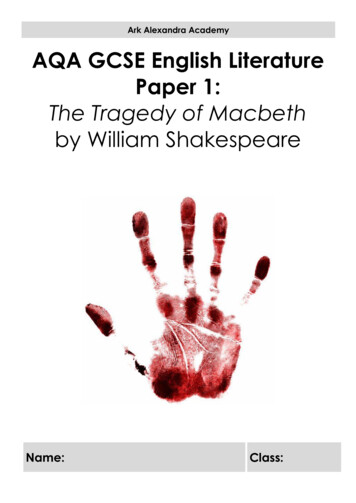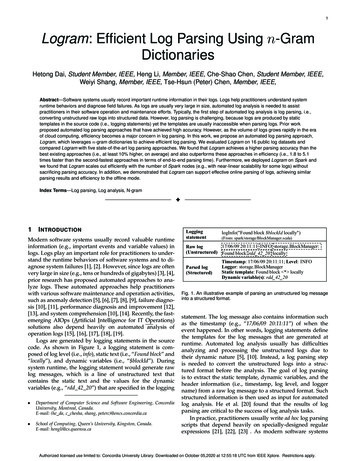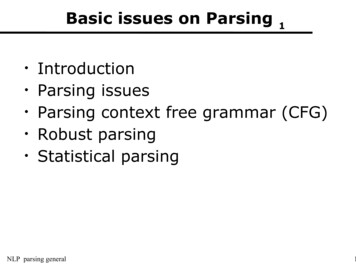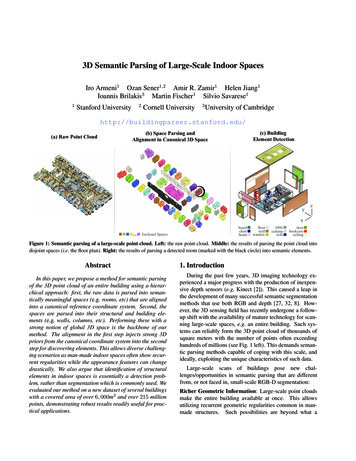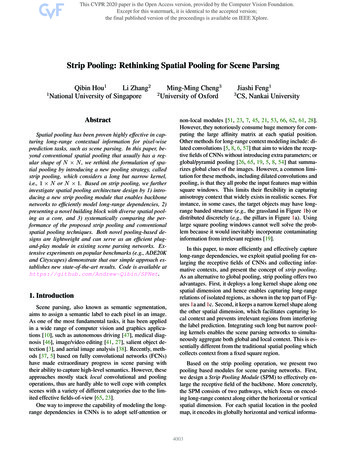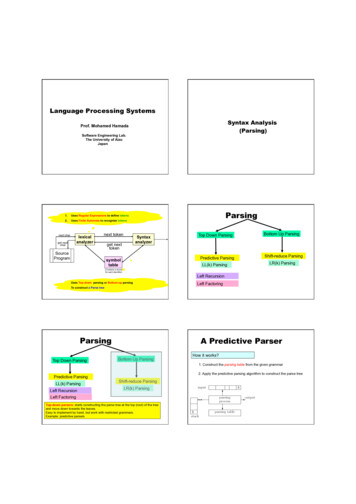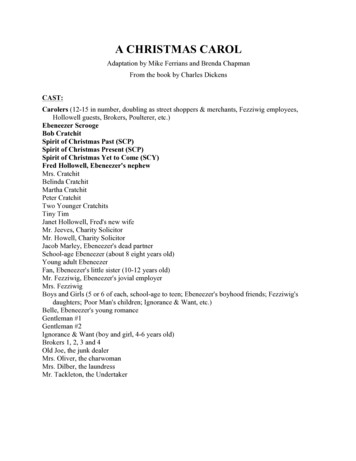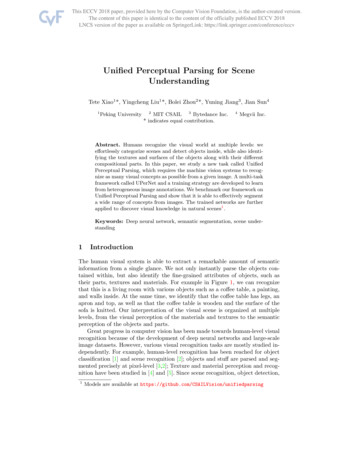
Transcription
Unified Perceptual Parsing for SceneUnderstandingTete Xiao1 *, Yingcheng Liu1 *, Bolei Zhou2 *, Yuning Jiang3 , Jian Sun41Peking University2MIT CSAIL 3 Bytedance Inc.* indicates equal contribution.4Megvii Inc.Abstract. Humans recognize the visual world at multiple levels: weeffortlessly categorize scenes and detect objects inside, while also identifying the textures and surfaces of the objects along with their differentcompositional parts. In this paper, we study a new task called UnifiedPerceptual Parsing, which requires the machine vision systems to recognize as many visual concepts as possible from a given image. A multi-taskframework called UPerNet and a training strategy are developed to learnfrom heterogeneous image annotations. We benchmark our framework onUnified Perceptual Parsing and show that it is able to effectively segmenta wide range of concepts from images. The trained networks are furtherapplied to discover visual knowledge in natural scenes1 .Keywords: Deep neural network, semantic segmentation, scene understanding1IntroductionThe human visual system is able to extract a remarkable amount of semanticinformation from a single glance. We not only instantly parse the objects contained within, but also identify the fine-grained attributes of objects, such astheir parts, textures and materials. For example in Figure 1, we can recognizethat this is a living room with various objects such as a coffee table, a painting,and walls inside. At the same time, we identify that the coffee table has legs, anapron and top, as well as that the coffee table is wooden and the surface of thesofa is knitted. Our interpretation of the visual scene is organized at multiplelevels, from the visual perception of the materials and textures to the semanticperception of the objects and parts.Great progress in computer vision has been made towards human-level visualrecognition because of the development of deep neural networks and large-scaleimage datasets. However, various visual recognition tasks are mostly studied independently. For example, human-level recognition has been reached for objectclassification [1] and scene recognition [2]; objects and stuff are parsed and segmented precisely at pixel-level [3,2]; Texture and material perception and recognition have been studied in [4] and [5]. Since scene recognition, object detection,1Models are available at https://github.com/CSAILVision/unifiedparsing
2T. Xiao, Y. Liu, B. Zhou, Y. Jiang, J. SunMaterialsParts- sofa is composed of seat cushion ,arm, back pillow and seat base.- coffee table is composed ofleg , apron and top.- cabinet is made of wood.- coffee table is made of wood.brickback pillow doorarmseat cushion topseat baseapronlegScenedrawerarmseat cushionback pillowwood- wall is made of brick.- sofa is made of fabric.- floor is made of tObjectsLiving roomwoodfabricwood- coffee table is waffled.- sofa is - wall is stratified.knittedwaffledporous- living room is composed of wall, floor, ceiling, coffeetable, cabinet and painting.Fig. 1. Network trained for Unified Perceptual Parsing is able to parse various visualconcepts at multiple perceptual levels such as scene, objects, parts, textures, and materials all at once. It also identifies the compositional structures among the detectedconcepts.texture and material recognition are intertwined in human visual perception,this raises an important question for the computer vision systems: is it possible for a neural network to solve several visual recognition tasks simultaneously?This motives our work to introduce a new task called Unified Perceptual Parsing(UPP) along with a novel learning method to address it.There are several challenges in UPP. First, there is no single image datasetannotated with all levels of visual information. Various image datasets are constructed only for specific task, such as ADE20K for scene parsing [2], the Describe Texture Dataset (DTD) for texture recognition [4], and OpenSurfaces formaterial and surface recognition [6]. Next, annotations from different perceptuallevels are heterogeneous. For example, ADE20K has pixel-wise annotations whilethe annotations for textures in the DTD are image-level.To address the challenges above we propose a framework that overcomes theheterogeneity of different datasets and learns to detect various visual conceptsjointly. On the one hand, at each iteration, we randomly sample a data source,and only update the related layers on the path to infer the concepts from theselected source. Such a design avoids erratic behavior that the gradient withrespect to annotations of a certain concept may be noisy. On the other hand,our framework exploits the hierarchical nature of features from a single network,i.e., for concepts with higher-level semantics such as scene classification, theclassifier is built on the feature map with the higher semantics only; for lowerlevel semantics such as object and material segmentation, classifiers are built onfeature maps fused across all stages or the feature map with low-level semanticsonly. We further propose a training method that enables the network to predictpixel-wise texture labels using only image-level annotations.Our contributions are summarized as follows: 1) We present a new parsingtask Unified Perceptual Parsing, which requires systems to parse multiple visual
Unified Perceptual Parsing for Scene Understanding3concepts at once. 2) We present a novel network called UPerNet with hierarchicalstructure to learn from heterogeneous data from multiple image datasets. 3) Themodel is shown to be able to jointly infer and discover the rich visual knowledgeunderneath images.1.1Related workOur work is built upon the previous work of semantic segmentation and multitask learning.Semantic segmentation. To generate pixel-wise semantic predictions for agiven image, image classification networks [7,8,9,1] are extended to generatesemantic segmentation masks. Pioneering work by Chen et al. [10], based onstructure prediction, uses conditional random field (CRF) to refine the activations of the final feature map of CNNs. The most prevalent framework designed for this pixel-level classification task is the Fully Convolutional Network(FCN) [11], which replaces fully-connected layers in classification networks withconvolutional layers. Noh et al. [12] propose a framework which applies deconvolution [13] to up-sample low resolution feature maps. Yu and Vladlen [14] proposean architecture based on dilated convolution which is able to exponentially expand the receptive field without loss of resolution or coverage. More recently,RefineNet [15] uses a coarse-to-fine architecture which exploits all informationavailable along the down-sampling process. The Pyramid Scene Parsing Network (PSPNet) [16] performs spatial pooling at several grid scales and achievesremarkable performance on several segmentation benchmarks [17,18,2].Multi-task learning. Multi-task learning, which aims to train models to accomplish multiple tasks at the same time, has attracted attention since long before the era of deep learning. For example, a number of previous research worksfocus on the combination of recognition and segmentation [19,20,21]. More recently, Elhoseiny et al. [22] have proposed a model that performs pose estimationand object classification simultaneously. Eigen and Fergus [23] propose an architecture that jointly addresses depth prediction, surface normal estimation, andsemantic labeling. Teichmann et al. [24] propose an approach to perform classification, detection, and semantic segmentation via a shared feature extractor.Kokkinos proposes the UberNet [25], a deep architecture that is able to do sevendifferent tasks relying on diverse training sets. Another recent work [3] proposesa partially supervised training paradigm to scale up the segmentation of objectsto 3, 000 objects using box annotations only. Comparing our work with previousworks on multi-task learning, only a few of them perform multi-task learning onheterogeneous datasets, i.e., a dataset that does not necessarily have all levelsof annotations over all tasks. Moreover, although tasks in [25] are formed fromlow level to high level, such as boundary detection, semantic segmentation andobject detection, these tasks do not form the hierarchy of visual concepts. InSection 4.2, we further demonstrate the effectiveness of our proposed tasks andframeworks in discovering the rich visual knowledge from images.
42T. Xiao, Y. Liu, B. Zhou, Y. Jiang, J. SunDefining Unified Perceptual ParsingWe define the task of Unified Perceptual Parsing as the recognition of manyvisual concepts as possible from a given image. Possible visual concepts areorganized into several levels: from scene labels, objects, and parts of objects,to materials and textures of objects. The task depends on the availability ofdifferent kinds of training data. Since there is no single image dataset annotatedwith all visual concepts at multiple levels, we first construct an image datasetby combining several sources of image annotations.2.1DatasetsIn order to accomplish segmentation of a wide range of visual concepts from multiple levels, we utilize the Broadly and Densely Labeled Dataset (Broden) [26], aheterogeneous dataset that contains various visual concepts. Broden unifies several densely labeled image datasets, namely ADE20K [2], Pascal-Context [27],Pascal-Part [28], OpenSurfaces [6], and the Describable Textures Dataset (DTD) [4].These datasets contain samples of a broad range of scenes, objects, object parts,materials and textures in a variety of contexts. Objects, object parts and materials are segmented down to pixel level while textures and scenes are annotatedat image level.The Broden dataset provides a wide range of visual concepts. Nevertheless,since it is originally collected to discover the alignment between visual concepts and hidden units of Convolutional Neural Networks (CNNs) for networkinterpretability [26,29], we find that samples from different classes are unbalanced. Therefore we standardize the Broden dataset to make it more suitablefor training segmentation networks. First, we merge similar concepts across different datasets. For example, objects and parts annotations in ADE20K, PascalContext, and Pascal-Part are merged and unified. Second, we only include objectclasses which appear in at least 50 images and contain at least 50, 000 pixels inthe whole dataset. Also, object parts which appear in at least 20 images can beconsidered valid parts. Objects and parts that are conceptually inconsistent aremanually removed. Third, we manually merge under-sampled labels in OpenSurfaces. For example, stone and concrete are merged into stone, while clear plasticand opaque plastic are merged into plastic. Labels that appear in less than 50images are also filtered out. Fourth, we map more than 400 scene labels fromthe ADE20K dataset to 365 labels from the Places dataset [30].Table 1 shows some statistics of our standardized Broden, termed as Broden . It contains 57, 095 images in total, including 22, 210 images from ADE20K,10, 103 images from Pascal-Context and Pascal-Part, 19, 142 images from OpenSurfaces and 5, 640 images from DTD. Figure 2 shows the distribution of objectsas well as parts grouped by the objects to which they belong. We also provideexamples from each source of the Broden dataset in Figure 3.
1b)2.210vanchandelierswivel chairpool tablelightchest of kdogarmchairrockwall lumnbicycleclothcoffee tableashcanspotlightbenchboatbasketwork yvanstovetruckawningchest of drawerstraffic lightseatposterglassflagtelephonefire stertrade erboardpalm101001000 10000 100000SourcesADE [2]ADE [2], Pascal-Context[27]ADE [2], Pascal-Context[27]ADE [2], Pascal-Part [28]OpenSurfaces [6]DTD rsofaairplanebird100Categorysceneobjectobject w/ se platewindowdoorbalconyshop wingsternenginewheelarmseat cushionback pillowseat orsoheadmuzzleearlegheadboardfootboardlegside railsidearmbackseat cushionlegseat tdoortorsoheadearmuzzleeyedoor doorroofchimneyrailingmonitorkeyboardmousecomputer casespeakerheadcoachheadlighthead roofcoach roofpanesashlower sashupper sashcasingovenbutton reshadediffusorcanopybackplatecorner pocketside canopyarmbulbwheelwindowdoorlicense platewindshieldUnified Perceptual Parsing for Scene Understanding5Eval. Metricstop-1 acc.mIoU & pixel acc.mIoU (bg) & pixel acc.mIoU & pixel acc.top-1 acc.Table 1. Statistics of each label type in the Broden dataset. Evaluation metrics foreach type of labels are also listed.Fig. 2. a) Sorted object classes by frequency: we show top 120 classes selected fromthe Broden . Object classes that appear in less than 50 images or contain less than50, 000 pixels are filtered. b) Frequency of parts grouped by objects. We show only top30 objects with their top 5 frequent parts. The parts that appear in less than 20 imagesare filtered.MetricsTo quantify the performance of models, we set different metrics based on theannotations of each dataset. Standard metrics to evaluate semantic segmentationtasks include Pixel Accuracy (P.A.), which indicates the proportion of correctlyclassified pixels, and mean IoU (mIoU), which indicates the intersection-overunion (IoU) between the predicted and ground truth pixels, averaged over allobject classes. Note that since there might be unlabeled areas in an image, themIoU metric will not count the predictions on unlabeled regions. This wouldencourage people to exclude the background label during training. However, it
6T. Xiao, Y. Liu, B. Zhou, Y. Jiang, J. Sun Fig. 3. Samples from the Broden dataset. The ground-truth labels for scene andtexture are image-level annotations, while for object, part and material are pixel-wiseannotations. Object and part are densely annotated, while material is partially annotated. Images with texture labels are mostly such localized object regions.is not suitable for the evaluation of tasks like part segmentation, because forsome objects the regions with part annotations only account for a small numberof pixels. Therefore we use mIoU, but count the predictions in the backgroundregions, denoted as mIoU-bg, in certain tasks. In this way, excluding backgroundlabels during training will boost P.A. by a small margin. Nonetheless, it willsignificantly downgrade mIoU-bg performance.For object and material parsing involving ADE20K, Pascal-Context, andOpenSurfaces, the annotations are at pixel level. Images in ADE20K and PascalContext are fully annotated, with the regions that do not belong to any predefined classes categorized into an unlabeled class. Images in OpenSurfaces arepartially annotated, i.e., if several regions of material occur in a single image,more than one region may not be annotated. We use P.A. and mIoU metrics forthese two tasks.For object parts we use P.A. and mIoU-bg metrics for the above mentionedreason. The IoU of each part is first averaged within an object category, thenaveraged over all object classes. For scene and texture classification we reporttop-1 accuracy. Evaluation metrics are listed in Table 1.To balance samples across different labels in different categories we first randomly sample 10% of original images as the validation set. We then randomlychoose an image both from the training and validation set, and check if the annotations in pixel level are more balanced towards 10% after swapping these twoimages. The process is performed iteratively. The dataset is split into 51, 617images for training and 5, 478 images for validation.3Designing Networks for Unified Perceptual ParsingWe demonstrate our network design in Figure 4, termed as UPerNet (UnifiedPerceptual Parsing Network), based on the Feature Pyramid Network (FPN) [31].FPN is a generic feature extractor which exploits multi-level feature represen-
Unified Perceptual Parsing for Scene Understanding #! " # ! % "! " " ) ' ! " % % # ! (! #& ! ! ! 7 " " ! % ! " #! "! " ! % ! " #! % " ! # '# ! )' % % % #! " &"# & # "# !! & & !! &"# & !! " " " ' % " Fig. 4. UPerNet framework for Unified Perceptual Parsing. Top-left: The Feature Pyramid Network (FPN) [31] with a Pyramid Pooling Module (PPM) [16] appended on thelast layer of the back-bone network before feeding it into the top-down branch in FPN.Top-right: We use features at various semantic levels. Scene head is attached on thefeature map directly after the PPM since image-level information is more suitable forscene classification. Object and part heads are attached on the feature map fused byall the layers put out by FPN. Material head is attached on the feature map in FPNwith the highest resolution. Texture head is attached on the Res-2 block in ResNet [1],and fine-tuned after the whole network finishes training on other tasks. Bottom: Theillustrations of different heads. Details can be found in Section 3.tations in an inherent and pyramidal hierarchy. It uses a top-down architecturewith lateral connections to fuse high-level semantic information into middle andlow levels with marginal extra cost. To overcome the issue raised by Zhou etal. [32] that although the theoretical receptive field of deep CNN is large enough,the empirical receptive field of deep CNN is relatively much smaller [33], we apply a Pyramid Pooling Module (PPM) from PSPNet [16] on the last layer of thebackbone network before feeding it into the top-down branch in FPN. Empirically we find that the PPM is highly compatible with the FPN architecture bybringing effective global prior representations. For further details on FPN andPPM, we refer the reader to [31] and [16].With the new framework, we are able to train a single network which is ableto unify parsing of visual attributes at multiple levels. Our framework is basedon Residual Networks [1]. We denote the set of last feature maps of each stagein ResNet as {C2 , C3 , C4 , C5 }, and the set of feature maps put out by FPN as{P2 , P3 , P4 , P5 }, where P5 is also the feature map directly following PPM. Thedown-sampling rates are {4, 8, 16, 32}, respectively. Scene label, the highest-levelattribute annotated at image-level, is predicted by a global average pooling of P5
8T. Xiao, Y. Liu, B. Zhou, Y. Jiang, J. Sunfollowed by a linear classifier. It is worth noting that, unlike frameworks based ona dilated net, the down-sampling rate of P5 is relatively large so that the featuresafter global average pooling focus more on high-level semantics. For object label,we empirically find that fusing all feature maps of FPN is better than only usingthe feature map with the highest resolution (P2 ). Object parts are segmentedbased on the same feature map as objects. For materials, intuitively, if we haveprior knowledge that these areas belong to the object “cup”, we are able tomake a reasonable conjecture that it might be made up of paper or plastics.This context is useful, but we still need local apparent features to decide whichone is correct. It should also be noted that an object can be made up of variousmaterials. Based on the above observations, we segment materials on top of P2rather than fused features. Texture label, given at the image-level, is based onnon-natural images. Directly fusing these images with other natural images isharmful to other tasks. Also we hope the network can predict texture labels atpixel level. To achieve such a goal, we append several convolutional layers ontop of C2 , and force the network to predict the texture label at every pixel.The gradient of this branch is prevented from back-propagating to layers ofbackbone networks, and the training images for texture are resized to a smallersize ( 64 64). The reasons behind these designs are: 1) Texture is the lowestlevel perceptual attribute, thus it is purely based on apparent features and doesnot need any high-level information. 2) Essential features for predicting texturecorrectly are implicitly learned when trained on other tasks. 3) The receptivefield of this branch needs to be small enough, so that the network is able topredict different labels at various regions when an image at normal scale is fedin the network. We only fine-tune the texture branch for a few epochs after thewhole network finishes training on other tasks.When only trained on object supervision, without further enhancements, ourframework yields almost identical performance as the state-of-the-art PSPNet,while requiring only 63% of training time for the same number of epochs. It isworth noting that we do not even perform deep supervision or data augmentations used in PSPNet other than scale jitter, according to the experiments intheir paper [16]. Ablation experiments are provided in Section 4.1.3.1Implementation detailsEvery classifier is preceded by a separate convolutional head. To fuse the layerswith different scales such as {P2 , P3 , P4 , P5 }, we resize them via bilinear interpolation to the size of P2 and concatenate these layers. A convolutional layeris then applied to fuse features from different levels as well as to reduce channel dimensions. All extra non-classifier convolutional layers, including those inFPN, have batch normalization [34] with 512-channel output. ReLU [35] is applied after batch normalization. Same as [36], we use the “poly” learning ratepolicy where the learning rate at current iteration equals the initial learning ratepoweritermultiplying 1 max. The initial learning rate and power are set toiter0.02 and 0.9, respectively. We use a weight decay of 0.0001 and a momentumof 0.9. During training the input image is resized such that the length of its
Unified Perceptual Parsing for Scene Understanding9shorter side is randomly chosen from the set {300, 375, 450, 525, 600}. For inference we do not apply multi-scale testing for fair comparison, and the length isset to 450. The maximum length of the longer side is set to 1200 in avoidance ofGPU memory overflow. The layers in the backbone network are initialized withweights pre-trained on ImageNet [37].During each iteration, if a mini-batch is composed of images from severalsources on various tasks, the gradient with respect to a certain task can benoisy, since the real batch size of each task is in fact decreased. Thus we randomlysample a data source at each iteration based on the scale of each source, andonly update the path to infer the concepts related to the selected source. Forobject and material, we do not calculate loss on unlabeled area. For part, asmentioned in Section 2.2, we add background as a valid label. Also the loss of apart is applied only inside the regions of its super object.Due to physical memory limitations a mini-batch on each GPU involves only2 images. We adopt synchronized SGD training across 8 GPUs. It is worth notingthat batch size has proven to be important to generate accurate statistics fortasks like classification [38], semantic segmentation [16] and object detection [39].We implement batch normalization such that it is able to synchronize acrossmultiple GPUs. We do not fix any batch norm layer during training. The numberof training iterations of ADE20k (with 20k images) alone is 100k. If trainedon a larger dataset, we linearly increase training iterations based on the numberof images in the dataset.3.2Design discussionState-of-the-art segmentation networks are mainly based on fully convolutionalnetworks (FCNs) [11]. Due to a lack of sufficient training samples, segmentationnetworks are usually initialized from networks pre-trained for image classification [37,7,8]. To enable high-resolution predictions for semantic segmentation,dilated convolution [14], a technique which removes the stride of convolutionallayers and adds holes between each location of convolution filters, has been proposed to ease the side effect of down-sampling while maintaining the expansionrate for receptive fields. The dilated network has become the de facto paradigmfor semantic segmentation.We argue that such a framework has major drawbacks for the proposed Unified Perceptual Parsing task. First, recently proposed deep CNNs [1,40], whichhave succeeded on tasks such as image classification and semantic segmentation usually have tens or hundreds of layers. These deep CNNs are intricatelydesigned such that the down-sampling rate grows rapidly in the early stage ofthe network for the sake of a larger receptive field and lighter computationalcomplexity. For example, in the ResNet with 100 convolutional layers in total,there are 78 convolutional layers in the Res-4 and Res-5 blocks combined, withdown-sampling rates of 16 and 32, respectively. In practice, in a dilated segmentation framework, dilated convolution needs to be applied to both blocks toensure that the maximum down-sampling rate of all feature maps do not exceed8. Nevertheless, due to the feature maps within the two blocks are increased to
10T. Xiao, Y. Liu, B. Zhou, Y. Jiang, J. SunMethodFCN [11]SegNet [42]DilatedNet [14]CascadeNet [2]RefineNet (Res-152) [15]DilatedNet † (Res-50) [16]PSPNet† (Res-50) [16]FPN (/16)FPN (/8)FPN (/4)FPN PPM (/4)FPN PPM Fusion (/4)Mean 935.2640.1341.22Pixel 221.227.838.7Table 2. Detailed analysis of our framework based on ResNet-50 v.s. state-of-the-artmethods on ADE20K dataset. Our results are obtained without multi-scale inference orother techniques. FPN baseline is competitive while requiring much less computationalresources. Further increasing resolution of feature maps brings consistent gain. PPM ishighly compatible with FPN. Empirically we find that fusing features from all levels ofFPN yields best performance. : A stronger reference for DilatedNet reported in [16].†: Training time is based on our reproduced models. We also use the same codes inFPN baseline.4 or 16 times of their designated sizes, both the computation complexity andGPU memory footprint are dramatically increased. The second drawback is thatsuch a framework utilizes only the deepest feature map in the network. Priorworks [41] have shown the hierarchical nature of the features in the network,i.e., lower layers tend to capture local features such as corners or edge/colorconjunctions, while higher layers tend to capture more complex patterns such asparts of some object. Using the features with the highest-level semantics mightbe reasonable for segmenting high-level concepts such as objects, but it is naturally unfit to segment perceptual attributes at multiple levels, especially thelow-level ones such as textures and materials. In what follows, we demonstratethe effectiveness and efficiency of our UPerNet.4ExperimentsThe experiment section is organized as follows: we first introduce the quantitativestudy of our proposed framework on the original semantic segmentation task andthe UPP task in Section 4.1. Then we apply the framework to discover visualcommon sense knowledge underlying scene understanding in Section 4.2.4.1Main resultsOverall architecture. To demonstrate the effectiveness of our proposed architecture on semantic segmentation, we report the results trained on ADE20K us-
Unified Perceptual Parsing for Scene Understanding11Training DataObjectPartSceneMaterialTexture O P S M T mI. P.A. mI.(bg) P.A.T-1 mI. P.A.T-1X24.72 78.03X- 52.78 84.32X X23.92 77.4830.21 48.30X X X23.83 77.2330.10 48.34 71.35X X X X23.36 77.0928.75 46.92 70.87 54.19 84.45X X X X X 23.36 77.0928.75 46.92 70.87 54.19 84.4535.10Table 3. Results of Unified Perceptual Parsing on the Broden dataset. O: Object. P:Part. S: Scene. M: Material. T: Texture. mI.: mean IoU. P.A.: pixel accuracy. mI.(bg):mean IoU including background. T-1: top-1 accuracy.ing object annotations under various settings in Table 2. In general, FPN demonstrates competitive performance while requiring much less computational resources for semantic segmentation. Using the feature map up-sampled only oncewith a down-sampling rate of 16 (P4 ), it reaches mIoU and P.A. of 34.46/76.04,almost identical to th
2 Defining Unified Perceptual Parsing We define the task of Unified Perceptual Parsing as the recognition of many visual concepts as possible from a given image. Possible visual concepts are organized into several levels: from scene labels, objects, and parts of objects, to materials and textures of objects. The task depends on the .
